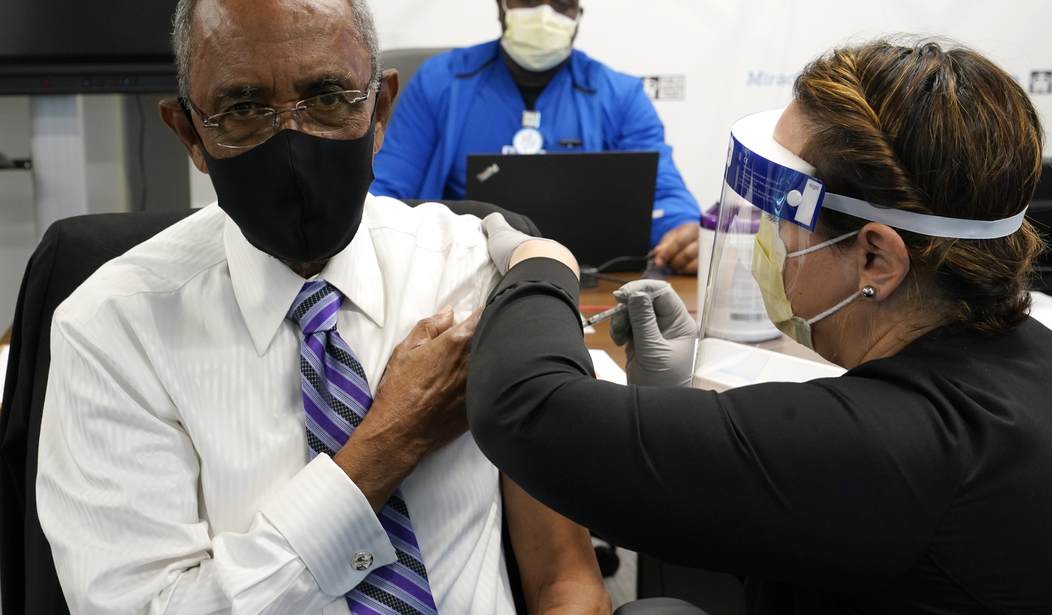An amazing statistic from a new CDC study to mark today’s milestone. Fifty percent of Americans are now fully vaccinated.
A total of 10,262 SARS-CoV-2 vaccine breakthrough infections had been reported from 46 U.S. states and territories as of April 30, 2021. Among these cases, 6,446 (63%) occurred in females, and the median patient age was 58 years (interquartile range = 40–74 years). Based on preliminary data, 2,725 (27%) vaccine breakthrough infections were asymptomatic, 995 (10%) patients were known to be hospitalized, and 160 (2%) patients died. Among the 995 hospitalized patients, 289 (29%) were asymptomatic or hospitalized for a reason unrelated to COVID-19. The median age of patients who died was 82 years (interquartile range = 71–89 years); 28 (18%) decedents were asymptomatic or died from a cause unrelated to COVID-19. Sequence data were available from 555 (5%) reported cases, 356 (64%) of which were identified as SARS-CoV-2 variants of concern,§ including B.1.1.7 (199; 56%), B.1.429 (88; 25%), B.1.427 (28; 8%), P.1 (28; 8%), and B.1.351 (13; 4%).
So, of the 995 out of 101 million who were hospitalized, only 706 were actually hospitalized due to COVID. That’s a rate of .00069 percent, or odds of 143,000 to one. Among the 160 who died, 132 died of COVID for a rate of .00013 percent. Or 765,000 to one.
As Larry David might say, pret-tay, pret-tay good.
Those figures come from a study of vaccinations conducted from January 1 to April 30. There’s a more recently updated page at the CDC website containing data on 123 million vaccinations through May 17:

That would be 1,368 hospitalizations linked to COVID, a rate of .0011 percent, and 290 deaths, or .00024 percent. One thing I don’t get, though, is how there could have been 160 deaths through April 30 and then another 130 deaths in the 17 days that followed. The total over four months in the study nearly doubled in less than three weeks afterward. Same goes for hospitalizations. Maybe I’m misunderstanding the data.
An important line from the CDC study: “[T]he number of reported COVID-19 vaccine breakthrough cases is likely a substantial undercount of all SARS-CoV-2 infections among fully vaccinated persons… Many persons with vaccine breakthrough infections, especially those who are asymptomatic or who experience mild illness, might not seek testing.” Many people, me included, have made that point in light of the weird outbreak among vaccinated coaches and staff on the Yankees. Only one of the nine who work for the team had symptoms; the only reason we know that the others were infected is because MLB requires team personnel to be tested three times a day. The average vaccinated American would have no reason to be tested if they were infected but asymptomatic, and even if they had mild symptoms they might assume that it’s the flu rather than COVID since they’ve been immunized. Bottom line: There are probably many, many more vaccinated people than we think walking around who are infected but protected and thus blissfully unaware.
Hospitalizations are a sturdier metric because if a breakthrough infection is bad enough to require a trip to the ER then it obviously won’t be missed by doctors. And precious few hospitalizations are happening among vaccinated people, thankfully.
There’s a controversy brewing over how the CDC intends to count breakthrough infections going forward, though. Until now, they’ve included anyone who’s tested positive in their official count, whether or not they’ve had symptoms. From now on, they’re going to track only severe cases in vaccinated people that require hospitalization. Which poses problems:
Critics say the agency is missing an important opportunity to learn about the real world effectiveness of the different vaccines, and gather information that might help identify trends in the pandemic’s trajectory — for example, how long vaccine protection lasts, or how various vaccines compare in preventing infection with variants, or whether certain patients like older people are more susceptible to breakthrough infections.
“We are driving blind, and we will miss a lot of signals,” said Ali Mokdad, an epidemiologist at the University of Washington who spent many years as a senior scientist at the C.D.C.
“The C.D.C. is a surveillance agency,” Dr. Mokdad said. “How can you do surveillance and pick one number and not look at the whole?”
If a new variant emerges that makes vaccinated people sick but not so sick that most need to go to the hospital, the CDC risks being slow to notice under its new policy. (Per the Times, more than half of the breakthrough cases for which genomic sequencing was done in the CDC study turned out to be variants.) The paper notes the case of a fully vaccinated woman who got infected, didn’t need hospital care, but has had lingering symptoms including fatigue. The CDC would have missed her too.
There’s a potential messaging problem too:
This is not a good answer. The result will be an inaccurate picture of the spectrum of severity in breakthrough cases, and a failure to capture the full benefits of vaccination in terms of severe infections averted. https://t.co/bE2uc00oyK
— Bill Hanage (@BillHanage) May 18, 2021
If all we hear about are cases in which breakthrough infections send someone to the hospital, the public will come to assume that breakthrough infections are hugely dangerous and prone to sending victims to the ER even though the opposite is true in nearly all instances.
On the other hand, how successful would the CDC be realistically in tracking mild or asymptomatic infections when we know that a huge number of those are being missed? If infected vaccinated people without symptoms are unlikely to be tested then by definition the agency won’t be getting a solid sample of what’s happening to the country at large in terms of variants, different age and racial demographics suffering special vulnerability, etc. I’m not sure there’s a good answer to that problem. The data on breakthrough infections is necessarily going to be incomplete.







Join the conversation as a VIP Member